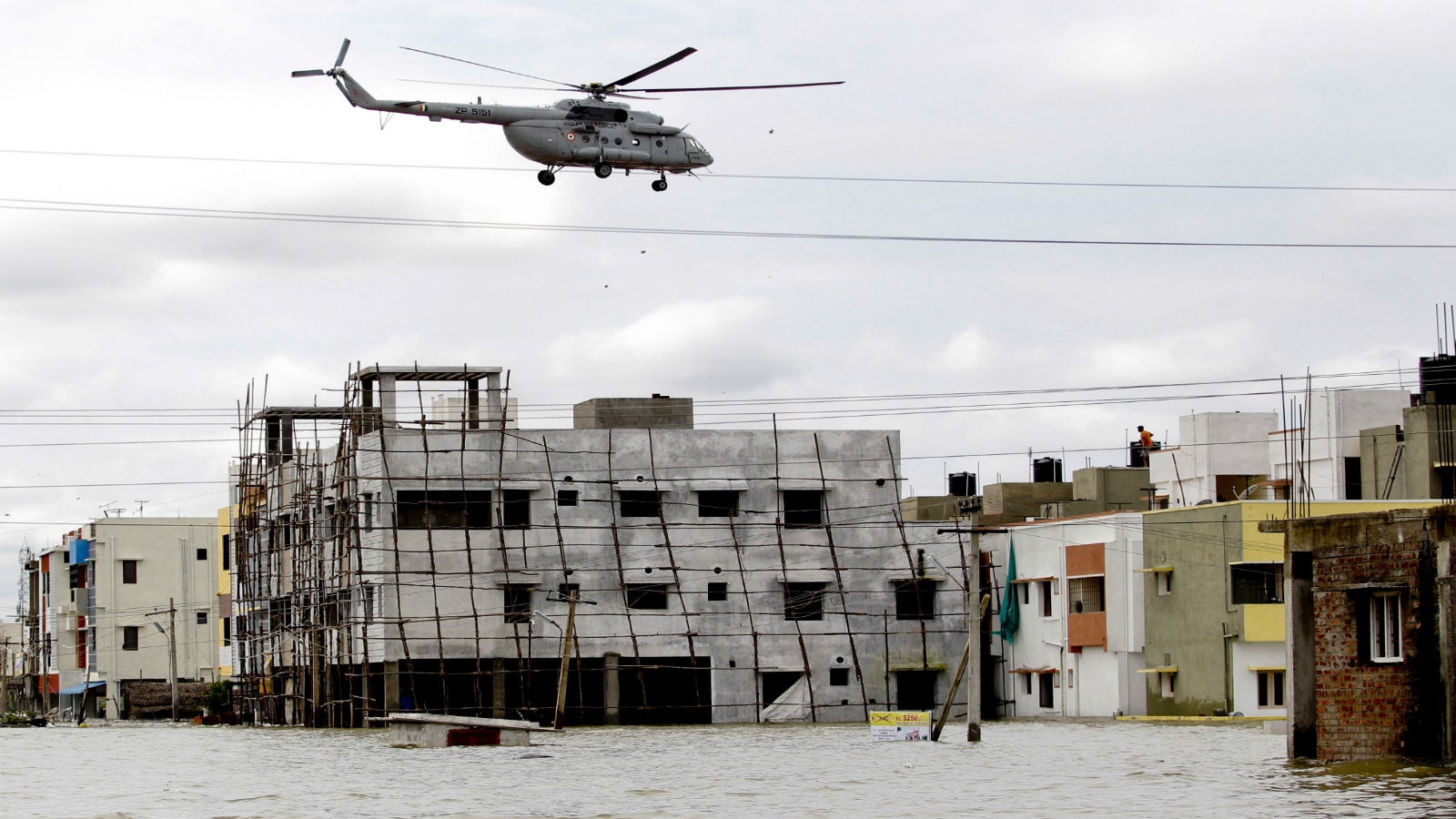The Indian Air Force’s dramatic mission to save a pregnant woman during the Chennai floods
A little past noon on Dec. 3, two Indian Air Force’s Cheetah helicopters finally appeared on the horizon.


A little past noon on Dec. 3, two Indian Air Force’s Cheetah helicopters finally appeared on the horizon.
Descending steadily, under an overcast sky, one headed straight for the rooftop of a two-storied building in Chennai’s Ramapuram neighbourhood.
Perched atop the building’s water tank, a 28-year-woman sat on a chair, with two men and her mother-in-law. Deftly, the helicopter manoeuvred itself, its landing skids barely a meter away from the tank. Without delay, a solider’s hand reached out for the younger woman, and within seconds, she was pulled safely into the helicopter.
The Cheetah then hovered momentarily. The woman’s bag had been forgotten. Quickly, that too, was passed on. There was no more waiting after that. A heavily-pregnant Deepthi Velchamy needed to get to a hospital as soon as possible.
It all began at around 8AM on Dec.3, when Velchamy went into labour.
Ordinarily, it would have been a quick drive to one of Chennai’s many hospitals, but the southern Indian metropolis was inundated by the heaviest monsoon rains in a century. The unprecedented rainfall—and subsequent flooding—had paralysed the city, and Velchamy was stuck inside her mother-in-law’s house, with water upto the first floor.
At first, a boat seemed the best option.
Like many other areas in Chennai, Ramapuram had been underwater for days. Instead of cars, residents were being forced to use boats on roads. Velchamy’s family and their neighbours went in search of one. But they quickly realised that it wasn’t going to work.
To begin with, reaching any of the National Disaster Response Force (NDRF) teams—a special force under the central government that specialises in disaster response—was difficult. The mobile phone networks were down, and when the family did manage to contact a team patrolling in the area, their boat could not enter the house since it was too big.
“Only the state-owned BSNL mobile phones were working through which we informed the NDRF team,” Annamalai, Velchamy’s neighbour, told Quartz. “But, when they arrived on boats a couple of hours later, she couldn’t get into one since it was very risky to come out. So, they (NDRF) immediately informed a helicopter that was patrolling the area about the crisis.”
A little before noon, Velchamy was shifted to the terrace of her building. ”For the helicopter to locate the house, we had to spread out a white saree on the terrace, and put a cross mark for the pilot to identify,” Sanjeev Kumar, Velchemy’s neighbour who was among the dozen people on the adjacent roof that morning, told Quartz.
The identification was successful, and the helicopter quickly arrived for the rescue. By 12.22 PM, Velchamy was safely airlifted, and then taken to the Air Force Base in Tambaram, a southern suburb of the city.
But it didn’t end there.
Once at the airforce base, Velchamy had to be shifted to the Sri Ramachandra Medical College and Hospital, a private medical college located 22 kilometres away in the western suburb of Porur. The 800-bed hospital had all her medical details in its online database, which she had lost during the floods.
“It was a very calculated risk by (the) IAF to rescue the pregnant woman without any delay,” Air Marshal SRK Nair told the New Indian Express newspaper.
“I was in Bengaluru when I received a call,” her husband Karthik Velchamy told the Press Trust of India, ”and I reached Tambaram the next day.”
The same day, the Velchamys became parents—of twin girls.